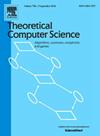Joint bidding in ad auctions
IF 1
4区 计算机科学
Q3 COMPUTER SCIENCE, THEORY & METHODS
引用次数: 0
Abstract
In traditional advertising auctions, commodity suppliers as advertisers compete for adverting positions to display commodities. As e-commerce platforms become more prevalent, offline retailers are also opening online virtual shops, and retailers are starting to pay a fee for extra exposure of their shops. This has led to situations where a single commodity may be sponsored by both the retailer and the supplier, offering opportunities for more profit. In order to explore this novel advertising pattern, we propose a new model called the joint advertising system (JAS), where retailers and suppliers jointly bid for advertising positions. In the context of this realistic scenario, conventional mechanisms such as GFP, GSP and Myerson auction cannot be applied directly. Besides, the VCG mechanism results in negative revenue in JAS. To solve this issue, we modify the payment rule of VCG to create a revised VCG mechanism that guarantees incentive compatible, individually rational and weakly budget-balanced. Additionally, we leverage the structure of the affine maximizer auction (AMA) and the technique of automated mechanism design to train joint AMA. Finally, we conduct several experiments to demonstrate the performance of the joint AMA. It turns out that our mechanism maintains good economic properties and outperforms other mechanisms in various settings.
广告拍卖中的联合投标
在传统的广告拍卖中,商品供应商作为广告商竞争展示商品的广告位置。随着电子商务平台的日益普及,线下零售商也开始开设在线虚拟商店,零售商开始为其商店的额外曝光支付费用。这导致了一种情况,即单一商品可能由零售商和供应商共同赞助,从而提供了获得更多利润的机会。为了探索这种新颖的广告模式,我们提出了一种称为联合广告系统(JAS)的新模式,即零售商和供应商共同竞标广告位置。在这种现实情况下,GFP、GSP和Myerson拍卖等传统机制不能直接适用。此外,VCG机制导致JAS的负收益。为了解决这一问题,我们修改了VCG的支付规则,建立了一个保证激励相容、个体理性和弱预算平衡的VCG机制。此外,我们利用仿射最大化拍卖(AMA)的结构和自动化机构设计技术来训练关节AMA。最后,我们进行了几个实验来验证联合AMA的性能。事实证明,我们的机制保持了良好的经济特性,并在各种情况下优于其他机制。
本文章由计算机程序翻译,如有差异,请以英文原文为准。
求助全文
约1分钟内获得全文
求助全文
来源期刊

Theoretical Computer Science
工程技术-计算机:理论方法
CiteScore
2.60
自引率
18.20%
发文量
471
审稿时长
12.6 months
期刊介绍:
Theoretical Computer Science is mathematical and abstract in spirit, but it derives its motivation from practical and everyday computation. Its aim is to understand the nature of computation and, as a consequence of this understanding, provide more efficient methodologies. All papers introducing or studying mathematical, logic and formal concepts and methods are welcome, provided that their motivation is clearly drawn from the field of computing.
 求助内容:
求助内容: 应助结果提醒方式:
应助结果提醒方式:


